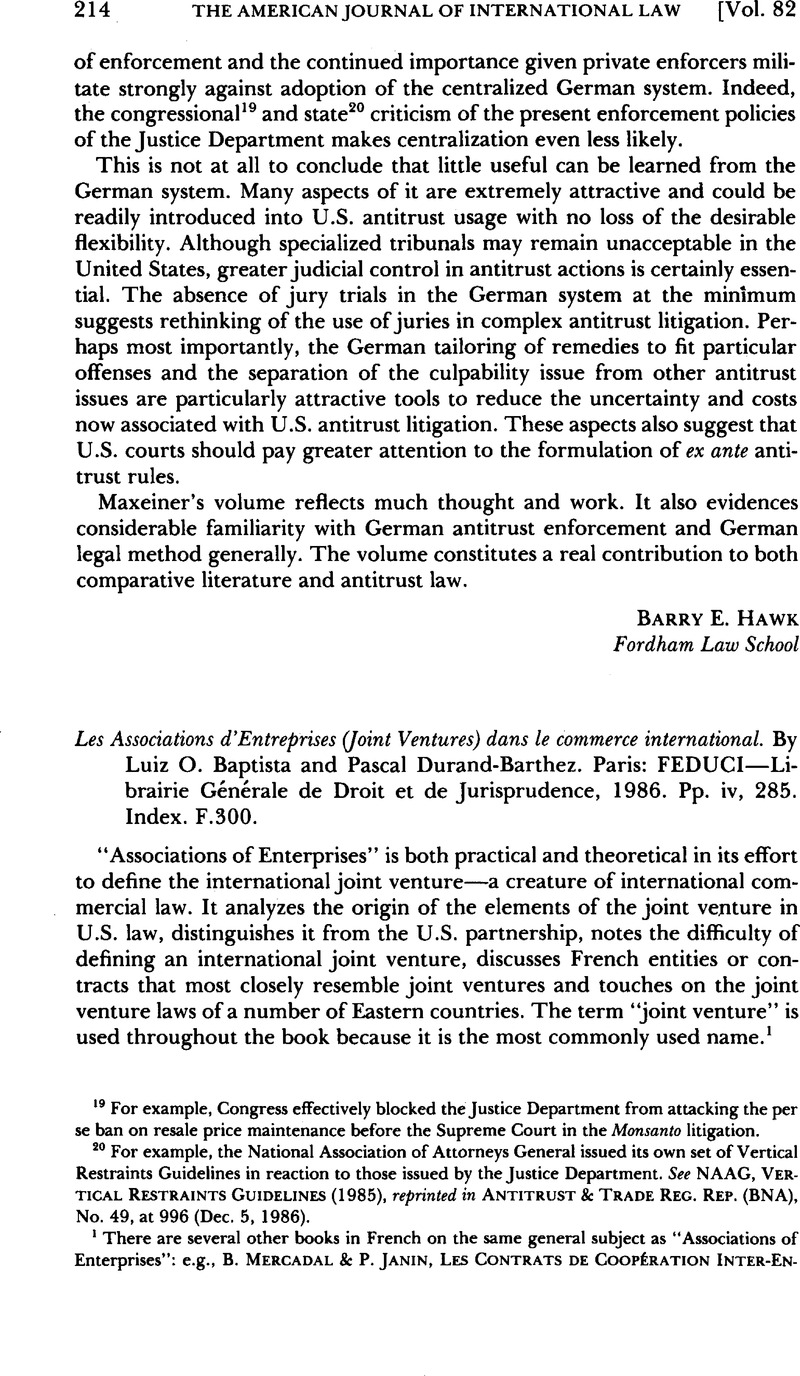No CrossRef data available.
Article contents
Les Associations d’Entreprises (Joint Ventures) dans le commerce international. By Luiz O. Baptista and Pascal Durand-Barthez. Paris: FEDUCI—Librairie Générale de Droit et de Jurisprudence, 1986. Pp. iv, 285. Index. F.300.
Published online by Cambridge University Press: 27 February 2017
Abstract

- Type
- Book Reviews and Notes
- Information
- Copyright
- Copyright © American Society of International Law 1988
References
1 There are several other books in French on the same general subject as “Associations of Enterprises”: e.g., Mercadal, B. & Janin, P. Les Contrats de Coopération Inter-En Trepr1ses (1st ed. 1974)Google Scholar, does not refer to the term “joint venture” except to say it is a competitor in international business language with “coopération inter-entreprise” (p. 3). This book is primarily focused on France, although it does have sections on international arbitration, international contracts and choice of laws.
M. Dubisson, Les Groupements D’entreprises Pour Les Marchés Internationaux (1979), and P. Franceschini & L. Pelissier, Droit Et Pratique des Unions Et Groupements D’Entreprises (1981), are oriented more toward the construction industry.
Baptista and Durand-Barthez’s book, which focuses primarily on developing countries, is by far the most international in scope, although the Dubisson book has a section on the Belgian, English, Swiss and German law on temporary associations and partnerships.
2 In Host Country Regulation of Joint Ventures and Foreign Investment (p. 110), Jesuald W. Salacuse defines an international joint venture as “essentially an economic or financial relationship which may be cast into a variety of legal forms, depending upon the law of the host country in question.” American Bar Association, Joint Venturing Abroad: A Case Study (1985).
Other attempts at definition have been made in the context of EEC antitrust law. See CCH Explanation of Art. 85(3) of the Treaty of Rome, 2 Common Mkt. Rep. (CCH) ¶2061.13, at 1673–2, where a “joint venture is generally described as an enterprise subject to joint control by two or more companies that are economically independent of each other.” 2 Smit, H. & Herzog, P. The Law of the European Economic Community, at 3–199 (1986)Google Scholar, offer the following: “Every collaborative effort on some aspect of the production and marketing process may be termed a joint venture.”
3 See David N. Goldsweig’s foreword in Joint Venturing Abroad: A Case Study, supra note 2. This book provides a hypothetical case, form agreements and articles on various aspects of joint ventures.
Friedmann, W. & Kalmanoff, G. Joint International Business Ventures (1961)Google Scholar, concluded that joint ventures were increasing in number and constituted an important postwar expression of changing relationships between industrially developed and less-developed countries.
4 Politique De La Concurrence Et Les Entreprises Communes 13(1986), published by the OFJCD, gives us an idea of the importance of the international joint venture in the EEC. Increasing concentrations of industry are occurring not only through acquisitions but also through agreements between independent companies, which, if highly integrated, are often like partial mergers.
In 1974, 49% of all mergers and acquisitions taking place in the EEC were in the form of joint venturelike arrangements (entreprises communes). The percentage dropped to 26 in 1982–1983. However, in 1982 and 1983, the number of international joint ventures with third countries equaled intracommunity joint ventures and in 1983–1984, their number exceeded the latter. Likewise, two-thirds of Switzerland’s joint ventures were between Swiss and foreign companies.
According to ICC statistics for 1986, 14% of the cases in arbitration related to joint ventures, which indicates considerable interest in this form of doing business and also illustrates that serious conflicts arise. These statistics are found on page 3 of a speech by Stephen R. Bond, Secretary General of the I.C.C. Court of Arbitration, Paris, “Arbitration of Construction Disputes under Auspices of the International Chamber of Commerce,” given before the Second Annual Construction Litigation Superconference, April 8–9, 1987.
5 See Reynolds, The “Pinched Shoe” Effect of International Joint Ventures, Colum. J. World Bus., Summer 1984, at 23. The conclusion of this study is that three-fourths of the 52 Indian-U.S. joint ventures studied survived profitably for 10 years or more. Nevertheless, even though the initial aims of the partners were reasonably congruent, as time passed, the changing locus of power led to a divergence in objectives. In almost every instance, this divergence tended to reduce the value of the joint venture as an instrument of the aims of the American partner. Thus, although most of the American firms continued their Indian ventures, they found the “fit” less comfortable than at the outset and this “pinched shoe” effect eventually dissolved the partnership for some of them.
In the worst situation in case of a breakup, a company, by entering into a joint venture and contributing technology, may have merely created a powerful competitor with lower labor costs.
6 Business International will soon publish a major research report on competitive alliances, i.e., joint ventures and other forms of collaboration, recounting the experiences of over 40 European, U.S. and Japanese firms. Bi/Ideas in Action, June 8, 1987, reports on a 50:50 joint venture between Italy’s Montedison and the U.S.’s Hercules, combining complementary strengths, i.e., leading technology (Montedison) and a global distribution network (Hercules).


